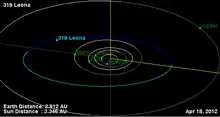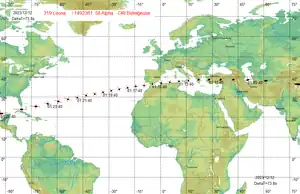 Orbital diagram of Leona | |
| Discovery [1] | |
|---|---|
| Discovered by | A. Charlois |
| Discovery site | Nice Obs. |
| Discovery date | 8 October 1891 |
| Designations | |
| (319) Leona | |
| Pronunciation | /liːˈoʊnə/[2] |
Named after | unknown Leona[3] |
| A920 HE | |
| main-belt · (outer) [1][4] | |
| Orbital characteristics [1] | |
| Epoch 4 September 2017 (JD 2458000.5) | |
| Uncertainty parameter 0 | |
| Observation arc | 125.32 yr (45,774 days) |
| Aphelion | 4.1451 AU |
| Perihelion | 2.6655 AU |
| 3.4053 AU | |
| Eccentricity | 0.2172 |
| 6.28 yr (2,295 days) | |
| 21.414° | |
| 0° 9m 24.48s / day | |
| Inclination | 10.564° |
| 184.95° | |
| 228.27° | |
| Physical characteristics | |
| Dimensions | 49.943±0.477 km[5] 54.136±1.193 km[6] 65.90±0.92 km[7] 67.97 km (derived)[4] 89.00±27.92 km[8] |
| 9.06±0.05 h (fragmentary)[9] 9.6 h (fragmentary)[9] 14.9±0.1 h (fragmentary)[10] 430±2 h[11] | |
| 0.02±0.02[8] 0.0318 (derived)[4] 0.0374±0.0191[6] 0.051±0.002[7] 0.085±0.005[5] | |
| P [6] · X [12] · C [4] | |
| 9.8[7][6] · 10.09±0.10[12] · 10.17[8] · 10.2[1][4] · 10.46±0.06[11] | |
319 Leona (provisional designation A920 HE), is a dark asteroid and tumbling slow rotator from the outermost regions of the asteroid belt, approximately 70 kilometers in diameter. It was discovered on 8 October 1891, by French astronomer Auguste Charlois at Nice Observatory in southeastern France.[13] Any reference of its name to a person is unknown.[3] On 12 December 2023 Leona will occult Betelgeuse as seen from southern Europe.[14]
Classification and orbit
Leona orbits the Sun in the outer main-belt at a distance of 2.7–4.1 AU once every 6 years and 3 months (2,295 days). Its orbit has an eccentricity of 0.22 and an inclination of 11° with respect to the ecliptic.[1]
The asteroid's observation arc begins at the discovering observatory, one night after its official discovery observation.[13]
Physical characteristics
Spectral type
Leona has been characterized as a dark and reddish P-type asteroid by the Wide-field Infrared Survey Explorer (WISE), and as an X-type asteroid by Pan-STARRS photometric survey.[6] The Collaborative Asteroid Lightcurve Link groups it to the carbonaceous C-type asteroids.[4]
Slow rotator and tumbler
In October 2016, a rotational lightcurve of Leona was obtained from photometric observations by astronomers Frederick Pilcher (see naming cite for 1990 Pilcher) at Organ Mesa Observatory (G50), United States, Lorenzo Franco at Balzaretto Observatory (A81), Italy, and Petr Pravec at the Ondřejov Observatory, Czech Republic. Lightcurve analysis gave a well-defined rotation period of 430±2 hours with a brightness variation of 0.5 magnitude (U=3).[11]
This makes Leona one of the Top 100 slowest rotators known to exist. The astronomers also detected a non-principal axis rotation seen in distinct rotational cycles in successive order. This tumbling also gives an alternative candidate period solution of 1084±10 hours, one of the longest periods ever measured.[11] It is the third-largest tumbler known to exist (also see List of tumblers).
Previous observations of Leona gave a much shorter period between 6 and 15 hours,[9][10] which demonstrates the intricacy when observing slow rotators, especially those with a tumbling motion. A detailed description of the procedure of the photometric measurement is given by Pilcher.[11]
Diameter and albedo
According to the surveys carried out by the Japanese Akari satellite and the NEOWISE mission of NASA's WISE space-telescope, Leona measures between 49.943 and 89.00 kilometers in diameter and its surface has an albedo between 0.02 and 0.085.[5][6][7][8] CALL derived an albedo of 0.0318 and a diameter of 67.97 kilometers based on an absolute magnitude of 10.2.[4]
Naming
The origin of this minor planet's name is unknown.[3]
Among the many thousands of named minor planets, Leona is one of 120 asteroids for which no official naming citation has been published. All of these low-numbered asteroids have numbers between 164 Eva and 1514 Ricouxa and were discovered between 1876 and the 1930s, predominantly by astronomers Auguste Charlois, Johann Palisa, Max Wolf and Karl Reinmuth.[15]
2023 occultation of Betelgeuse
 Predicted path of the occultation of Betelgeuse by the asteroid (319) Leona on 12 December 2023, using the SOLEX software
Predicted path of the occultation of Betelgeuse by the asteroid (319) Leona on 12 December 2023, using the SOLEX software
On 12 December 2023 at about 01:09–01:27 UT, Leona will occult Betelgeuse as seen from southern Europe, Turkey, Greece and Sicily.[14] The 14th magnitude asteroid will occult Betelgeuse (block or reduce the light) for about 12 seconds. Betelgeuse is expected to dim by about 3 magnitudes.[16]
The occultation path starts in eastern China, then crosses Tajikistan, Turkmenistan, Azerbaijan, Armenia, Turkey, Greece, Italy, Spain, Portugal, the southern tip of Florida (US) and finally ends in Mexico.[17]
Light curve studies of the event may help understand the distribution of brightness over the disk of Betelgeuse. As Leona moves across the stellar disk it will pass over large convection cells on the surface of Betelgeuse which are brighter than the average of the surface. Brightness measurements therefore could provide information on the distribution of these cells.[18]
Observations of other occultations by 319 Leona in September 2023 showed the asteroid is slightly elliptical and enabled the construction of a preliminary 3D model of Leona. The model also confirms its size to be about 80 by 55 kilometres and it is believed Leona will have a silhouette of about 46 by 41 milliarcseconds (mas).[18][19][20] Betelgeuse has an apparent size in the sky of about 40 mas, but its diffuse atmosphere may make it appear around 50 mas in size. If Betelgeuse appears larger than Leona its light won't be completely blocked, but if not, there will be a narrow strip of “totality” a few kilometers wide around the center line, where the star completely disappears for something between 5 and 15 seconds.[18]
References
- 1 2 3 4 5 "JPL Small-Body Database Browser: 319 Leona" (2017-02-04 last obs.). Jet Propulsion Laboratory. Retrieved 26 July 2017.
- ↑ Noah Webster (1884) A Practical Dictionary of the English Language
- 1 2 3 Schmadel, Lutz D. (2007). "(319) Leona". Dictionary of Minor Planet Names – (319) Leona. Springer Berlin Heidelberg. p. 42. doi:10.1007/978-3-540-29925-7_320. ISBN 978-3-540-00238-3.
- 1 2 3 4 5 6 7 "LCDB Data for (319) Leona". Asteroid Lightcurve Database (LCDB). Retrieved 26 July 2017.
- 1 2 3 Masiero, Joseph R.; Grav, T.; Mainzer, A. K.; Nugent, C. R.; Bauer, J. M.; Stevenson, R.; et al. (August 2014). "Main-belt Asteroids with WISE/NEOWISE: Near-infrared Albedos". The Astrophysical Journal. 791 (2): 11. arXiv:1406.6645. Bibcode:2014ApJ...791..121M. doi:10.1088/0004-637X/791/2/121. S2CID 119293330. Retrieved 26 July 2017.
- 1 2 3 4 5 6 Mainzer, A.; Grav, T.; Masiero, J.; Hand, E.; Bauer, J.; Tholen, D.; et al. (November 2011). "NEOWISE Studies of Spectrophotometrically Classified Asteroids: Preliminary Results". The Astrophysical Journal. 741 (2): 25. arXiv:1109.6407. Bibcode:2011ApJ...741...90M. doi:10.1088/0004-637X/741/2/90. S2CID 35447010.
- 1 2 3 4 Usui, Fumihiko; Kuroda, Daisuke; Müller, Thomas G.; Hasegawa, Sunao; Ishiguro, Masateru; Ootsubo, Takafumi; et al. (October 2011). "Asteroid Catalog Using Akari: AKARI/IRC Mid-Infrared Asteroid Survey". Publications of the Astronomical Society of Japan. 63 (5): 1117–1138. Bibcode:2011PASJ...63.1117U. doi:10.1093/pasj/63.5.1117. (online, AcuA catalog p. 153)
- 1 2 3 4 Nugent, C. R.; Mainzer, A.; Bauer, J.; Cutri, R. M.; Kramer, E. A.; Grav, T.; et al. (September 2016). "NEOWISE Reactivation Mission Year Two: Asteroid Diameters and Albedos". The Astronomical Journal. 152 (3): 12. arXiv:1606.08923. Bibcode:2016AJ....152...63N. doi:10.3847/0004-6256/152/3/63.
- 1 2 3 Behrend, Raoul. "Asteroids and comets rotation curves – (319) Leona". Geneva Observatory. Retrieved 26 July 2017.
- 1 2 Alkema, Michael S. (October 2013). "Asteroid Lightcurve Analysis at Elephant Head Observatory: 2013 April-July". The Minor Planet Bulletin. 40 (4): 215–216. Bibcode:2013MPBu...40..215A. ISSN 1052-8091. Retrieved 26 July 2017.
- 1 2 3 4 5 Pilcher, Frederick; Franco, Lorenzo; Pravec, Petr (April 2017). "319 Leona and 341 California - Two Very Slowly Rotating Asteroids" (PDF). The Minor Planet Bulletin. 44 (2): 87–90. Bibcode:2017MPBu...44...87P. ISSN 1052-8091. Retrieved 26 July 2017.
- 1 2 Veres, Peter; Jedicke, Robert; Fitzsimmons, Alan; Denneau, Larry; Granvik, Mikael; Bolin, Bryce; et al. (November 2015). "Absolute magnitudes and slope parameters for 250,000 asteroids observed by Pan-STARRS PS1 - Preliminary results". Icarus. 261: 34–47. arXiv:1506.00762. Bibcode:2015Icar..261...34V. doi:10.1016/j.icarus.2015.08.007. S2CID 53493339. Retrieved 26 July 2017.
- 1 2 "319 Leona". Minor Planet Center. Retrieved 26 July 2017.
- 1 2 Denissenko, Denis (3 October 2004). "Unique occultations". Archived from the original on 16 December 2012.
- ↑ Schmadel, Lutz D. (2007). "Appendix 11 – Minor Planet Names with Unknown Meaning". Dictionary of Minor Planet Names – Fifth Revised and Enlarged revision. Springer Berlin Heidelberg. pp. 927–929. ISBN 978-3-540-00238-3.
- ↑ Steve Preston. "Asteroidal Occultation Prediction: (319)Leona". Asteroid Occultation Updates. Retrieved 16 June 2023. hal-astro-lab
- ↑ Kretlow, Mike; Ortiz, Jose Luiz; Schnabel, Carles. "The Occultation of Betelgeuse by (319) Leona on 2023 Dec 12" (PDF). Journal for Occultation Astronomy. 13 (4): 3–8.
- 1 2 3 Hattenbach, Jan (12 November 2023). "ASTEROID WILL COVER BETELGEUSE, MAY REVEAL ITS VISIBLE SURFACE". Sky & Telescope. Retrieved 18 November 2023.
- ↑ Ortiz, J. L.; Kretlow, M.; Schnabel, C.; Morales, N.; Flores-Martín, J.; González, M. Sánchez; Casarramona, F.; Selva, A.; Perelló, C. (21 September 2023). "The stellar occultation by (319) Leona on 13 September 2023 in preparation for the occultation of Betelgeuse". arXiv:2309.12272v1 [astro-ph.EP].
- ↑ "(319) Leona - physical model to predict the occultation of Betelgeuse". sirrah.troja.mff.cuni.cz. Retrieved 18 November 2023.
External links
- Asteroid Lightcurve Database (LCDB), query form (info Archived 16 December 2017 at the Wayback Machine)
- Dictionary of Minor Planet Names, Google books
- Asteroids and comets rotation curves, CdR – Observatoire de Genève, Raoul Behrend
- Discovery Circumstances: Numbered Minor Planets (1)-(5000) – Minor Planet Center
- 319 Leona at AstDyS-2, Asteroids—Dynamic Site
- 319 Leona at the JPL Small-Body Database